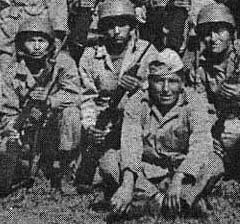
from Navajo Times
 from Navajo Times |
10:00 - FDR declares war Dec. 8, 1941, scenes of war mobilization, Philip Johnston city engineer in Los Angeles and had been raised on Navajo reservation and WWI vet and conceived of idea to use Navajo language for war communication, team set up in San Diego at Marine base and Navajo code comunication proved effective, specially trained marines would learn code
13:30 - this highly select group became known as code-talkers; unlike Choctaws of WWI who used a limited code, the Navajo language was more complex, a dictionary was published by missionaries in 1910, but only a handful of people outside the reservation could speak the language; 30 Navajos chosen for training
15:00 - Japan expanded in the Pacific in 1942, then came Midway and the Navy broke the JN-25 Japan naval code
18:00 - Navajo Code Talkers had to be fluent in English as well as Navajo (interviews by Carl Gorman & Keith Little & Thomas Begay, codetalkers; also Tom Thomas, military historian); were sent to Marine Corps boot camp in San Diego; 1st group graduated June 1942; then sent to new Navajo Communication School at Camp Elliot in San Diego; code created from 200 common battle terms, using many nature terms in Navajo, submarine was "iron fish" and fighter plane was "hummingbird"; code also included Navajo term for each letter of the alphabet, withe the most common vowels and consonants given several different Navajo terms; Navy cryptologists tried to break the code but were unsuccessful; learned how to use different radios at Camp Elliott, esp. the TBX workhorse radio of the Marines and Navy that used a spool of wire attached to a pole for antenna and powered by battery or hand crank; 1st group graduated from the school summer 1942; Jeremiah 5:15
28:00 - Gaudalcanal in August 1942, but code only used occasionally; each team had 2 Navajos; teams worked at all levels from HQ to squads on the front; used field telephone more than radio, connected by wire up to 1/2 mile from front to rear lines, but vulnerable to intercept by Japanese; clip of Navajo talking in code; on Guadacanal one code talker Paul Blatchford was captured and misidentified as Japanese, and therefore were given Marine bodyguards
35:00 - Pendleton became new home of the code school in 1943; by fall, more Navajos were assigned to the Pacific; scenes of code talk from Bougainville and Tarawa and Cape Gloucester (audio of code talking with subtitles); scene from Hollywood movie "get Crazy Horse on the horn" 38:00 - Iwo Jima - code talkers played major role; quote from Marine Gen. Howland Smith; code had matured and the 50 Navajos assigned to Iwo Jima were experienced; performed traditional Navajo prayer before battle; landings began 8:30 am Feb. 19, 1945; over 800 messages sent on first day during which 548 Marines were killed; 22 or 88 Medals of Honor awarded to Marines in WWII were from Iwo Jima, the co; flag 1st raised by 6 Marines Feb. 23 on Mt. Suribachi and later that day 2nd flag raising by another 6 marines included Ira Hayes, 4 Navajos killed on Iwo Jima
49:00 - Okinawa, Hiroshima, Nagasaki, Japanese surrender; scene of part of MacArthur's speech on the USS Missouri
52:00 - codetalkers discharged after war to keep their code secret; many returned to civilian life after war and led reforms for Indians; 1969 recognition; Aug. 14, 1982, was proclaimed National Navajo Code Talker Day by President Reagan and statue of young boy raised in Phoenix, Arizona, to commemorate code talkers 55:00 - dedicated to the 25,000 Native Americans who served in World War II, including 3600 Navajos in all military branches and the 420 code talkers in the Marine Corps
56:00 - credits - Nina D. Begay performs Marine Corps Hymn with drum and sung in Navajo language